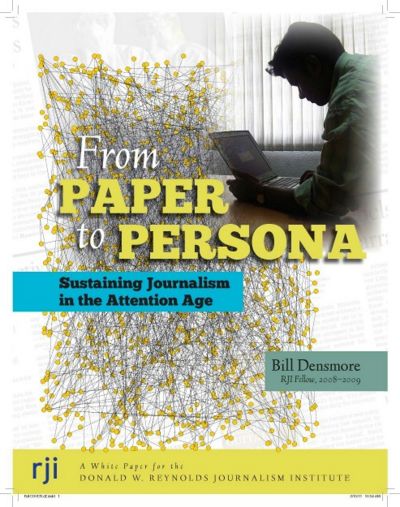Persona
Contents
BRANSON, Mo., Aug. 4, 2011 -- A non-profit collaboration to share technology, users and content could help news organizations find new revenues and become better at serving the public, according to a report by a Donald W. Reynolds Journalism Institute researcher at the University of Missouri.
READ MORE:
ANNOUNCEMENT
FULL PAPER
BLOG & COMMENTS
NEWS RELEASE ONLY
FACEBOOK UPDATES PAGE (RSS FEED)
VIDEO -- ITA EXPLAINED IN 1:23 MINS.
The report, “From Paper to Persona: Managing Privacy and Information Overload; Sustaining Journalism in the Attention Age,” was published Thurs., Aug. 4 and presented to the annual meeting of the Newspaper Association Managers Inc., meeting in Missouri. It’s the result of more than two years of study by a Reynolds fellow and consultant, Bill Densmore, a career journalist, publisher and entrepreneur.
VIEW SLIDES FROM BRANSON
“As news and the economics of newspapers come unglued, what will sustain journalism?” Densmore asks. “The answer involves a challenge and an opportunity. The challenge is how to do a better job of helping the public find knowledge they need, amid a glut so huge that the scarce human commodity is now attention, not information. The Internet provides the opportunity to do so.”
The report advocates forming an industry collaborative, tentatively called the “Information Trust Association” by Densmore. It would define and foster a common technology playing field that respects consumer privacy, and makes rules for the exchange of both content and users’ identity information.
“Such a system might allow news originators of any size – possibly including bloggers – to exchange payments among each other and with public users for news information and sponsored material,” says Densmore.
Two thirds of the 55-page paper chronicles what Densmore says is the end of mass markets as a viable strategy for selling the advertising that has largely supported American journalism. Instead, he says, the Internet is increasingly able to deliver commercial messages targeted to specific users’ interests and profiles – or personas.
As a result, the paper says, publishers and broadcasters have to learn how to use technology to become expert at personalizing information services. And that, says Densmore, requires them to help consumers with their privacy and personal information. They might help users to earn rewards, or pay for specialized information.
The last third of the paper argues that the Information Trust Association is the best way to help with this change. The idea is potentially controversial because the U.S. news industry has not typically cooperated on technology standards, instead being buffeted and shrunk by services originated elsewhere such as Craig’s List, eBay, Facebook or Google.
“The point of the Information Trust Association would be to foster collaboration that increases convenience and choice for consumers, allowing multiple service providers to compete on a common playing field,” says Densmore. The paper offers nine examples of industries where this has occurred, including railroads, cable TV, the electric grid, electrical equipment, banking and stock exchange, and the Internet itself.
The genesis of the paper was Densmore’s 2008-2009 “Information Valet Project” fellowship at Reynolds.
“Our challenge is no longer how to access information, but how to manage our time and attention amid the glut. News organizations have the opportunity to move from being paid to deliver one-format products (broadcasts, print stories, to providing trusted multimedia, personalized services with unique insight, knowledge, curation, and aggregation. They can help users manage their privacy and identity — their persona,” says Densmore.
The white paper is now available to view and download online. Rich with more than 230 live links to additional resources and reading, “From Paper to Persona” can be found here: http://rjionline.org/news/paper-persona
To comment, join a discussion or learn more about next steps for the Information Trust Association idea, read Densmore’s blog post at: http://tinyurl.com/persona-blog
EXCERPTS: Time to make the marketplace for privacy, trust, identity and information commerce
A growing attention economy is transforming the news business. It represents for the institutions which practice journalism a chance to survive beyond the era of mass-market advertising, by becoming “information valets” for their readers, viewers and users. Trust, access, identity and value are core issues, affecting convenience, privacy and personalization. The attention economy will invite new collaboration among news, advertising, publishing, entertainment, technology and philanthropic services.
As the news and paper come unglued, what will pay for journalism in the new news ecosystem? We need a new digital marketplace for information. Managing information overload is an opportunity. That’s what this forthcoming white paper is about. It suggests how publishers can cultivate customized, one-to-one relationships with users, provide them personalized information, and get paid for doing so.
News organizations need new revenues to improve journalism’s service to participatory democracy. They might provide a new service to the public besides trying to sell stories. Managing the privacy and information preferences of individuals is one such opportunity.
READ SHORT EXECUTIVE SUMMARY
READ FULL PAPER ONLINE or DOWNLOAD PDF
READ EARLY COMMENTS
ADD BLOG COMMENTS
VIEW BILL DENSMORE PRESENTATION
DOWNLOAD SEVEN-PAGE SUMMARY
LISTEN to April 27 discussion
Thus the defining new-revenue challenge for news organizations in the 21st century is no longer just managing proprietary information, but learning to help the public manage our attention to ubiquitous information. In less than a decade, we have moved from a world of relative information scarcity -- access restricted by a variety of technical choke points -- such as presses -- to a world of such information abundance that the average user's challenge is not how to access information, or even how find it, but how to personalize, trust and make sense of it.
The Internet as we know it today is not up to this task. “From Paper to Persona: Managing Privacy and Information Overload; Sustaining Journalism in an Attention Age,” explains how a new public-benefit collaboration could help stop the shrinking of American journalism.
REFERENCE LINKS
An Information Trust Association will recognize in its governance structure the interests of at least four different constituencies: rights-holders (authors/artists), publishers (aggregators), audience-owners (banks, publishers, billers etc.), and end-users.
